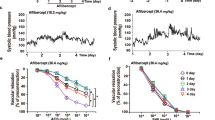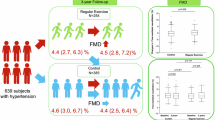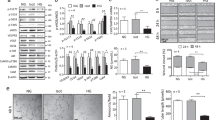Abstract
Endothelial function is impaired in essential hypertension. T-type but not L-type voltage-gated Ca2+ channels were detected in the vascular endothelium. The purpose of the present study was to clarify the role of T-type Ca2+ channels in endothelial function. We studied flow-mediated vasodilation (FMD) and sublingual nitroglycerin (NTG)-induced vasodilation in the brachial artery. Forty patients with essential hypertension were randomly assigned to treatment with efonidipine, a T- and L-type Ca2+ channel blocker, or with nifedipine, an L-type Ca2+ channel blocker. Twenty healthy normotensive individuals were included as a control group. In patients with essential hypertension, FMD was attenuated and NTG was similar that of compared to healthy controls. After 12 weeks, the decrease in mean blood pressure in the efonidipine and nifedipine groups were similar. The endothelial function index, a ratio of FMD/NTG, was significantly increased by efonidipine (73±24 to 94±20%) but unchanged by nifedipine. Urinary excretion 8-hydroxy-2′-deoxyguanosine (8-OHdG) and serum malondialdehyde-modified low-density lipoprotein (LDL) were decreased by efonidipine but unchanged by nifedipine. These results suggest that a T-type Ca2+ channel blocker, but not an L-type Ca2+ channel blocker, may improve vascular endothelial dysfunction in patients with essential hypertension via a reduction in oxidative stress.
Similar content being viewed by others
Article PDF
References
Ross A : Atherosclerosis—an inflammatory disease. N Engl J Med 1999; 340: 115–126.
Panza JA, Quyyumi AA, Brush JE Jr, Epstein SE : Abnormal endothelium-dependent vascular relaxation in patients with essential hypertension. N Engl J Med 1990; 323: 22–27.
Moriguchi J, Itoh H, Harada S, et al: Low frequency regular exercise improves flow-mediated dilation of subjects with mild hypertension. Hypertens Res 2005; 28: 315–321.
Higashi Y, Oshima T, Ozono R, Matsuura H, Kajiyama G : Aging and severity of hypertension attenuate endothelium-dependent renal vascular relaxation in humans. Hypertension 1997; 30: 252–258.
Egashira K, Suzuki S, Hirooka Y, et al: Impaired endothelium-dependent vasodilation in large epicardial and resistance coronary arteries in patients with essential hypertension. Hypertension 1995; 25: 201–206.
Tarutani Y, Matsumoto T, Takashima H, Yamane T, Horie M : Brachial artery flow-mediated vasodilation is correlated with coronary vasomotor and fibrinolytic response induced by bradykinin. Hypertens Res 2005; 28: 59–66.
Staessen JA, Li Y, Thijs L, Wang JG : Blood pressure reduction and cardiovascular prevention: an update including the 2003–2004 secondary prevention trials. Hypertens Res 2005; 28: 385–407.
Ghiadoni L, Magagna A, Versari D, et al: Different effect of antihypertensive drugs on conduit artery endothelial function. Hypertension 2003; 41: 1281–1286.
Iwatsubo H, Nagano M, Sakai T, et al: Converting enzyme inhibitor improves forearm reactive hyperemia in essential hypertension. Hypertension 1997; 29: 286–290.
Hirooka Y, Imaizumi T, Masaki H, et al: Captopril improves impaired endothelium-dependent vasodilation in hypertensive patients. Hypertension 1992; 20: 175–180.
Millgard J, Hagg A, Sarabi M, Lind L : Captopril, but not nifedipine, improves endothelium-dependent vasodilation in hypertensive patients. J Hum Hypertens 1998; 12: 511–516.
Taddei S, Virdis A, Ghiadoni L, et al: Restoration of nitric oxide availability after calcium antagonist treatment in essential hypertension. Hypertension 2001; 37: 943–948.
Wu S, Haynes J, Taylor JT, et al: Cav 3.1 (α1G) T-type Ca2+ channels mediate vaso-occlusion of sickled erythrocytes in lung microcirculation. Circ Res 2003; 93: 346–353.
Yazawa K, Ono K, Iijima T : Modulation by mibefradil of the histamine-induced Ca2+ entry in human aoritic endothelial cells. Jpn J Pharmacol 2002; 90: 125–130.
Nilius B, Prenen J, Kamouchi M, Viana F, Voets T, Droogmans G : Inhibition by mibefradil, a novel calcium antagonist, of Ca2+- and volume-activated Cl− channels in macrovascular endothelial cells. Br J Pharmacol 1997; 121: 547–555.
Masumiya H, Shijuku T, Tanaka H, Shigenobu K : Infibition of myocardial L- and T-type Ca2+ currents by efonidipine: possible mechanism for its chronotropic effect. Eur J Pharmacol 1998; 349: 351–357.
Oshima T, Ozono R, Yano Y, et al: Association of Helicobacter pylori infection with systemic inflammation and endothelial dysfunction in healthy male subjects. J Am Coll Cardiol 2005; 45: 1219–1222.
Boulanger CM, Nakashima M, Olmos L, Joly G, Vanhoutte PM : Effects of the Ca2+ antagonist RO 40–5967 on endothelium-dependent responses of isolated arteries. J Cardiovasc Pharmacol 1994; 23: 869–876.
Boulanger CM, Desta B, Clozel JP, Vanhoutte PM : Chronic treatment with the Ca2+ channel inhibitor RO 40–5967 potentiates endothelium-dependent relaxations in the aorta of the hypertensive salt sensitive Dahl rat. Blood Press 1994; 3: 193–196.
Nomura S, Kanazawa S, Fukuhara S : Effects of efonidipine on platelet and monocyte activation markers in hypertensive patients with and without type 2 diabetes mellitus. J Hum Hypertens 2002; 16: 539–547.
Hagiwara N, Irisawa H, Kameyama M : Contribution of two types of calcium currents to the pacemaker potentials of rabbit sinoatrial node cells. J Physiol 1988; 395: 233–253.
Tseng GN, Boyden PA : Multiple types of Ca2+ currents in single canine Purkinje cells. Circ Res 1989; 65: 1735–1750.
Chen C, Lamping KG, Nuno DW, et al: Abnormal coronary function in mice deficient in α1H T-type Ca2+ channels. Science 2003; 302: 1416–1418.
Vanbavel E, Sorop O, Andreasen D, Pfaffendorf M, Jensen BL : Role of T-type calcium channels in myogenic tone of skeletal muscle resistance arteries. Am J Physiol 2002; 283: H2239–H2243.
Hornig B, Landmesser U, Kohler C : Comparative effect of ACE inhibition and angiotensin II type 1 receptor antagonism on the biovailability of nitric oxide in patients with coronary artery disease: role of superoxide dismutase. Circulation 2001; 103: 799–805.
Higashi Y, Sasaki S, Nakagawa K, Matsuura H, Oshima T, Chayama K : Endothelial function and oxidative stress in renovascular hypertension. N Engl J Med 2002; 346: 1954–1962.
Maggi E, Marchesi E, Ravette V, Martignoni A, Finardi G, Bellomo G : Presence of autoantibodies against oxidatively modified low-density lipoprotein in essential hypertension: a biochemical signature of an enhanced in vivo low-density lipoprotein oxidation. J Hypertens 1995; 13: 129–138.
Mak TI, Boehme P, Weglicki WB : Antioxidant effects of calcium channel blockers against free radical injury in endothelial cells. Circ Res 1992; 70: 1099–1103.
Umemoto S, Tanaka M, Kawahara S, et al: Calcium antagonist reduces oxidative stress by upregulating Cu/Zn superoxide dismutase in stroke-prone spontaneously hypertensive rats. Hypertens Res 2004; 27: 877–885.
Yasunari K, Maeda K, Nakamura M, Watanabe T, Yoshikawa J : Benidipine, a long-acting calcium channel blocker, inhibits oxidative stress in polymorphonuclear cells in patients with essential hypertension. Hypertens Res 2005; 28: 107–112.
Correti MC, Anderson TJ, Benjamin EJ, et al: Guidelines for the ultrasound assessment of endothelial-dependent flow-mediated vasodilation of the brachial artery. J Am Coll Cardiol 2002; 39: 257–265.
Author information
Authors and Affiliations
Corresponding author
Rights and permissions
About this article
Cite this article
Oshima, T., Ozono, R., Yano, Y. et al. Beneficial Effect of T-Type Calcium Channel Blockers on Endothelial Function in Patients with Essential Hypertension. Hypertens Res 28, 889–894 (2005). https://doi.org/10.1291/hypres.28.889
Received:
Accepted:
Issue date:
DOI: https://doi.org/10.1291/hypres.28.889
Keywords
This article is cited by
-
Efonidipine Exerts Cerebroprotective Effect by Down-regulation of TGF-β/SMAD-2-Dependent Signaling Pathway in Diabetic Rats
Journal of Molecular Neuroscience (2021)
-
Pathophysiological roles and therapeutic potential of voltage-gated ion channels (VGICs) in pain associated with herpesvirus infection
Cell & Bioscience (2020)
-
Deficiency of T-type voltage-gated calcium channels results in attenuated weight gain and improved endothelium-dependent dilatation of resistance vessels induced by a high-fat diet in mice
Journal of Physiology and Biochemistry (2020)
-
In vitro study of carbon black nanoparticles on human pulmonary artery endothelial cells: effects on calcium signaling and mitochondrial alterations
Archives of Toxicology (2020)
-
Potential Protective Role of Blood Pressure-Lowering Drugs on the Balance between Hemostasis and Fibrinolysis in Hypertensive Patients at Rest and During Exercise
American Journal of Cardiovascular Drugs (2019)



